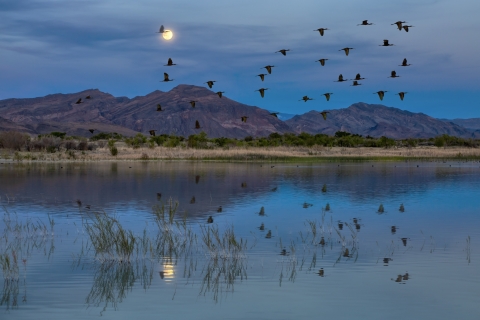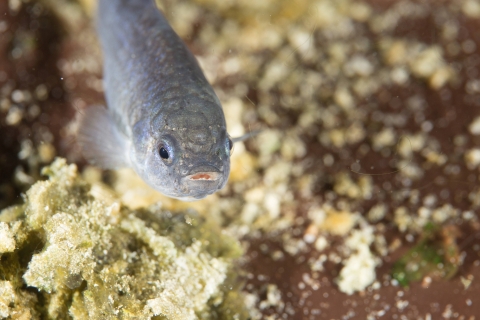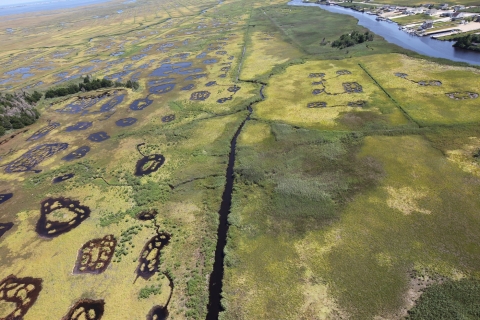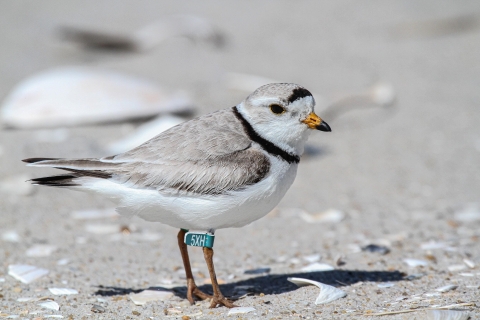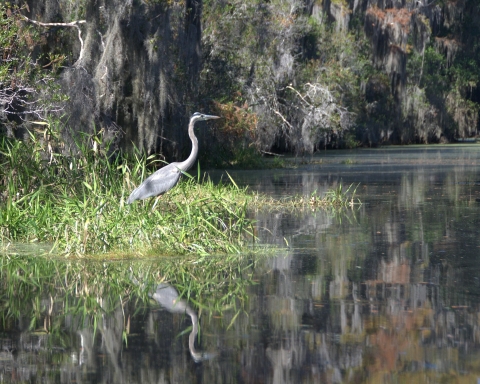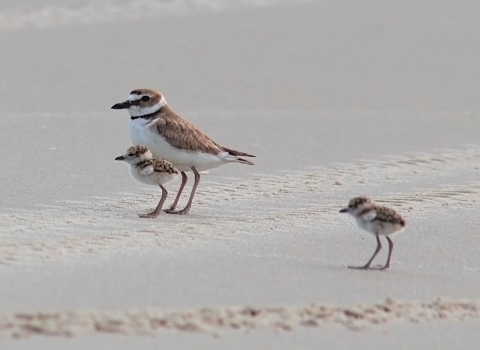The Ramsar Convention, the oldest modern global intergovernmental environmental agreement, encourages the designation of sites containing representative, rare or unique wetlands, or wetlands that are important for conserving biological diversity. The United States boasts 41 Ramsar sites across the United States totaling over 4.6 million acres. Twenty- three of these sites fall completely or partially within National Wildlife Refuges managed by the U.S. Fish and Wildlife Service.
Here’s a look at the first four U.S. Ramsar sites, dedicated on December 18, 1986 (all National Wildlife Refuges) and what makes them worthy of international recognition!
Ash Meadows National Wildlife Refuge in Nevada
Despite being in the hottest and driest corner of the United States, Ash Meadows National Wildlife Refuge is home to the second greatest concentrations of endemic species in North America. In just under 24,000 acres live 26 species found nowhere else on Earth. That’s because approximately 10,000 years ago, as the climate warmed, aquatic species survived by seeking refuge in receding and fragmenting wetlands. Isolated for millennia, the survivors evolved into new species in separated “islands of water” scattered across a sea of desert. Nearly all of Ash Meadows’ endemic species live in or around its 50 springs and seeps.
Ash Meadows’ miraculous wetland endemism is what qualified it as a Wetland of International Importance 35 years ago. At Ash Meadows, the desert springs to life with rare and endemic species of aquatic animals and wildflowers where perennial outflow from springs and a shallow water table support alkali meadows, alkali seeps, and the refuge’s eponymous ash groves. Fourteen federally protected threatened and endangered species and over 100 state protected and priority species live on the refuge. The springs also provide habitat for megafauna like parched desert bighorn sheep. Ash Meadows is a gathering place so bountiful in nature’s diversity it can be easy to forget that it is surrounded on nearly all its sides by one hundred miles of desert.
More Site Facts
- Within Ash Meadows’ springs and spring outflows live two varieties of charismatic pupfish, a speckled dace, 10 spring snail species, 2 water bugs, and a rifle beetle.
- The surrounding alkali soils’ proximity to groundwater provide habitat for nine endemic wildflowers and a multitude of other rare ones.
- Spring-fed reservoirs, emergent marshes, and mesquite bosques host over 275 species of birds, many international visitors on layover as they journey along the Pacific Flyway.
Edwin B. Forsythe National Wildlife Refuge in New Jersey
Edwin B. Forsythe National Wildlife Refuge protects more than 47,000 acres of coastal habitat. The refuge is within one of the Atlantic Flyway’s most active flight paths, providing vital rest and refueling habitat to over 200 species of migratory birds, including the threatened or endangered piping plover, least tern, and roseate tern.
Eighty-two percent of the refuge is wetland. Seventy-eight percent of this wetland habitat is salt marsh salt marsh
Salt marshes are found in tidal areas near the coast, where freshwater mixes with saltwater.
Learn more about salt marsh , some of the most ecologically productive land on Earth. Salt marshes serve as nurseries for young fish, nesting habitat for coastal songbirds, and feeding grounds for many species of ducks, geese, herons, and egrets. These salt marshes also provide other important benefits including: filtering runoff and excess nutrients to help maintain water quality in coastal communities, absorbing flood waters during storm events, and mitigating the effects of climate change climate change
Climate change includes both global warming driven by human-induced emissions of greenhouse gases and the resulting large-scale shifts in weather patterns. Though there have been previous periods of climatic change, since the mid-20th century humans have had an unprecedented impact on Earth's climate system and caused change on a global scale.
Learn more about climate change by sequestering and storing carbon.
More Site Facts
- The refuge supports rare sea-level fen communities, which in turn support six rare plant species.
- Peregrine falcons and ospreys frequent refuge wetlands and take advantage of the nesting platforms erected for their use.
- Each spring and fall tens of thousands of migrating ducks and geese, wading birds, and shorebirds congregate at the refuge.
Izembek National Wildlife Refuge in Alaska
Situated along the Ring of Fire between the Gulf of Alaska and the Bering Sea, Izembek National Wildlife Refuge hosts a stunning diversity of wildlife and cradles the famous Izembek Lagoon. The lagoon’s 150-square mile coastal wetland has one of the world’s largest eelgrass beds and provides a critical stopover for hundreds of thousands of migrating waterfowl to rest and refuel.
Since 1960, the lagoon and its associated state-owned tidal lands have been protected by Alaska as the Izembek State Game Refuge, while the National Wildlife Refuge surrounds the lagoon and protects the coastal uplands.
More Site Facts
- People have called this place home for thousands of years, thriving on the coastal bounty. The refuge is on the traditional homelands of the Unangax̂ people. The word for “Alaska” comes from the Unangax̂ word for the Alaska Peninsula, Alasxix, where Izembek is located.
- Almost the entire population of Pacific black brant (150,000 birds) stop in the lagoon on their migration from the high Arctic. Long distance fliers to the west coast of North America, they can cover a trans-Pacific route from Izembek to Baja flying over 3,000 miles non-stop in around 55 hours. Izembek’s eelgrass is the superfood, rich in protein and nutrients, that helps power their incredible journey.
- Izembek’s extensive wetlands provide shelter and nourishment for marine mammals such as sea otters, seals, Steller’s sea lions, and many species of fish — including four species of Pacific salmon as they migrate to and from the refuge’s freshwater streams.
Okefenokee National Wildlife Refuge in Georgia
Okefenokee National Wildlife Refuge, on the Atlantic and Gulf Coastal Plains of the southeastern United States, protects the world-renowned Okefenokee Swamp, an exceptional example of the southern yellow pine forests that was once the most extensive forest type in the United States. The diversity and distribution of 21 wetland and upland habitats at Okefenokee support over 1,270 flora and vertebrate fauna species, in addition to thousands of invertebrate species.
Okefenokee Swamp is the most complete, large freshwater wetland ecosystem remaining on the North American Coastal Plain and the largest blackwater wetland ecosystem in North America. It is world renowned for its biological diversity, particularly the range of amphibian and reptile species and the high number of regional endemic species. These species are adapted to the water and fire regimes that characterize each of Okefenokee’s many habitat types.
The refuge spans 407,000 acres, protecting approximately 93 percent of the wetlands that comprise the Okefenokee Swamp, and sees over 600,000 visitors annually, with 10 percent of the visitation represented by international guests from over 46 countries.
More Site Facts
- Okefenokee Refuge is a proposed World Heritage Site.
- In 2012, National Geographic magazine recognized the Okefenokee Swamp as one of the top 100 Most Beautiful Places on Earth.
- The swamp is world renowned for its amphibian populations that are bio-indicators of global health.
Explore More: Take a virtual tour of all U.S. Ramsar sites
Special thanks to contributors to this article:
- Ash Meadows: Adamas Weitzenfeld,Visitor Services Specialist
- Edwin B Forsythe: The National Wetlands Inventory Program and Ramsar
- Izembek: Lisa Hupp, Communications Coordinator
- Okefenokee: Susan Heisey, Supervisory Refuge Ranger
NOTE: some of the links go to non federal government websites. This does not constitute an endorsement of any products or services offered there.

